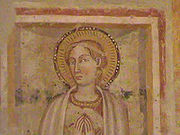
Pudentiana
Encyclopedia

Christianity
Christianity is a monotheistic religion based on the life and teachings of Jesus as presented in canonical gospels and other New Testament writings...
saint
Saint
A saint is a holy person. In various religions, saints are people who are believed to have exceptional holiness.In Christian usage, "saint" refers to any believer who is "in Christ", and in whom Christ dwells, whether in heaven or in earth...
of the 2nd century. She is sometimes called Potentiana and is often coupled with her sister, Praxedes
Praxedes
Saint Praxedes is a traditional Christian saint of the 2nd century. She is sometimes called Praxedis or Praxed.-Biography:Little is known for about Praxedes, and not all accounts agree. According to Jacobus de Voragine's The Golden Legend, Praxedes was the sister of Saint Pudentiana; their brothers...
.
According to her acta, published by the Bollandists (dating from the 8th century) and the Martyrology
Martyrology
A martyrology is a catalogue or list of martyrs , arranged in the calendar order of their anniversaries or feasts. Local martyrologies record exclusively the custom of a particular Church. Local lists were enriched by names borrowed from neighbouring churches...
of Reichenau, she was a Roman
Ancient Rome
Ancient Rome was a thriving civilization that grew on the Italian Peninsula as early as the 8th century BC. Located along the Mediterranean Sea and centered on the city of Rome, it expanded to one of the largest empires in the ancient world....
virgin of the early Christian church, daughter of Saint Pudens
Saint Pudens
Saint Pudens was an early Christian saint and martyr. 100px| left| thumb| Russian [[icon]].He is mentioned as a layman of the Roman Church in 2 Timothy 4:21. According to tradition, he lodged Saint Peter and was baptised by him, and was martyred under Nero...
, friend of the Apostles, and sister of Praxedes. Praxedes and Pudentiana, together with presbyter Pastor and Pope Pius I
Pope Pius I
Pope Saint Pius I was Bishop of Rome, according to the Annuario Pontificio, from 142 or 146 to 157 or 161, respectively. Others suggest that his pontificate was perhaps from 140 to 154.-Early life:...
, built a baptistry in the church inside their father's house, and started to baptize pagans. Pudentiana died at the age of 16, possibly a martyr, and is buried next to her father Pudens, in the Priscilla catacombs on the via Salaria
Via Salaria
The Via Salaria was an ancient Roman road in Italy.It eventually ran from Rome to Castrum Truentinum on the Adriatic coast - a distance of 242 km. The road also passed through Reate and Asculum...
.
While there is evidence for the life of Pudens, there is no direct evidence for neither Pudentiana nor Praxedes. It is possible that the early Church's "ecclesia Pudentiana" (i.e., the Church of Pudens) was mistaken for "Saint Pudentiana".
Pudentiana has a commemoration in the General Roman Calendar of 1962
General Roman Calendar of 1962
This article lists the feast days of the General Roman Calendar as it was in 1962, following the reforms that Pope John XXIII introduced with his motu proprio Rubricarum instructum of 23 July 1960...
on 19 May. Pudentiana is not included in the Roman Catholic calendar of saints
Roman Catholic calendar of saints
The General Roman Calendar indicates the days of the year to which are assigned the liturgical celebrations of saints and of the mysteries of the Lord that are to be observed wherever the Roman Rite is used...
nor in the present edition of the Roman Martyrology
Roman Martyrology
The Roman Martyrology is the official martyrology of the Roman Rite of the Roman Catholic Church. It provides an extensive but not exhaustive list of the saints recognized by the Church.-History:...
. Her basilica in Rome is Santa Pudenziana
Santa Pudenziana
The basilica of Santa Pudenziana is a 4th century church in Rome, dedicated to Saint Pudentiana, sister of Saint Praxedis and daughter of Saint Pudens. It is the national church of the Philippines....
.
The Spanish Conquistador
Conquistador
Conquistadors were Spanish soldiers, explorers, and adventurers who brought much of the Americas under the control of Spain in the 15th to 16th centuries, following Europe's discovery of the New World by Christopher Columbus in 1492...
Miguel López de Legaspi, who founded the city of Manila
Manila
Manila is the capital of the Philippines. It is one of the sixteen cities forming Metro Manila.Manila is located on the eastern shores of Manila Bay and is bordered by Navotas and Caloocan to the north, Quezon City to the northeast, San Juan and Mandaluyong to the east, Makati on the southeast,...
in 1571, gained possession of the territory on 19 May of that year, the feast of this saint (in Spanish
Spanish language
Spanish , also known as Castilian , is a Romance language in the Ibero-Romance group that evolved from several languages and dialects in central-northern Iberia around the 9th century and gradually spread with the expansion of the Kingdom of Castile into central and southern Iberia during the...
the name "Potentiana" takes the form "Potenciana"), and declared her patron saint of what is now the Philippines.

